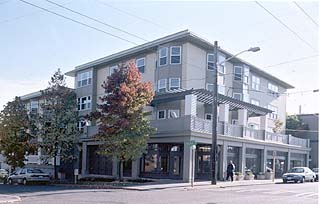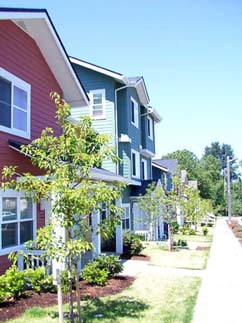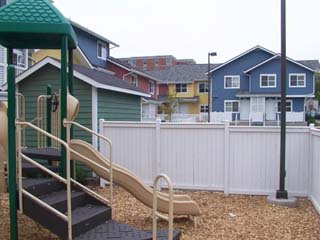
Surveys
DJC.COM
February 28, 2002
2,158 reasons to like nonprofit housing groups
HDC of Seattle

Photo by Doug Vann The Harrison, developed by the Capitol Hill Housing Improvement Program, features 19 affordable apartments and ground floor retail. |
Collectively, the nonprofit members of this affordable housing group opened 2,158 units of low-income housing in the Puget Sound region during 2001. This includes rental and ownership housing, as well as the preservation of 326 units of federally subsidized Section 8 housing for persons earning below 30 percent of median income.

Okigwe |
Following a decade of exceptional growth, housing rents and home purchase prices in the Puget Sound region climbed to levels that were unaffordable to many citizens, based on U.S. Department of Housing and Urban Development standards.
Affordable rental housing generally has a maximum income limit of 50 percent of median income. In King County, this equates to an annual income of $25,250 for one person or $32,500 for three persons. Homeowner programs allow a somewhat higher income level.
HDC members are the primary providers of affordable housing in King County and include 29 nonprofit organizations, as well as the Seattle and King County housing authorities. Our members are extremely creative when it comes to leveraging financing and building affordable housing that blends into the community.

Photo by Deanna Schow Longfellow Court in West Seattle is a mutual housing cooperative developed by the Lutheran Alliance to Create Housing and the Seattle Housing Authority.
|
They are opening doors to a wide range of folks in Puget Sound and other parts of the state. This housing serves low- and moderate-income working families and individuals, senior citizens, homeless women and children, women in transition, severely disabled youth, Section 8 households, persons with developmental disabilities and farm workers.
Targeting low and moderate incomes
Two-person households earning less than 50 percent of median income can afford about $723 in monthly rent. However, last year in King County $840 was the average monthly rent for a two-bedroom unit. Worse, only about 1 percent of all King County apartments are affordable to those earning less than 30 percent of median household income, where a two-person household can only afford a monthly rent of about $434.
Many full-time workers in service occupations — such as waiters, desk clerks, retail salespersons, fast food cooks and taxi drivers — earn 30 percent of median income. To fill this gap, the majority of the units opened by HDC members in 2001 were rental apartments targeted to households earning between 30 percent and 50 percent of median income ($15,150 to $25,250 for one person).
| Housing units opened in 2001 by HDC members |
|
Archdiocesan Housing Authority
50 units of farm worker housing Central Area Development Association 57 condominium units Capitol Hill Housing Improvement Program 19 apartments for low-income individuals/families Catholic Community Services 6 units for women in transition Downtown Action to Save Housing 97 apartments for families and seniors Delridge Neighborhoods Development Association 33 units for low-income families HomeSight 50 single-family homes and town homes for sale Childrens Country Home 8 units for disabled youth King County Housing Authority 152 units for Section 8 households; 506 units for low-income families and individuals Lutheran Alliance to Create Housing 45 units for low-income families and individuals Low Income Housing Institute 141 Section 8 units, 72 units for low-income families and individuals, 44 units for homeless women and children Mount Baker Housing Association 29 units for low-income families and individuals Multi-Service Center 24 units for low-income families, 19 transitional units for women Parkview Services 30 units for developmentally disabled persons Plymouth Housing Group 50 studio units for formerly homeless individuals St. Andrew’s Housing Group 18 low-income units for families/individuals Seattle Housing Authority 361 units for low-income families, 294 units for seniors Seattle Habitat for Humanity 14 for-sale homes South East Effective Development 39 low-income units for families/individuals |
Of the 36 housing developments opened by HDC members this past year in King County and around the state, 10 were in Seattle and were partially funded by the successful 1995 Seattle Housing Levy. That levy expires this year and Seattle residents will get the opportunity to vote on its renewal this fall.
Each dollar of the 1995 Seattle Housing Levy has been leveraged about 3.5 times by local nonprofit organizations that develop housing. Nonprofit housing developers provide an invaluable resource in the production of affordable housing.
Economic stimulator
Multi-family construction by nonprofit developers generates jobs and local taxes. According to the National Association of Home Builders (NAHB), 100 new multi-family units in an average city add $5.3 million in local income — wages for workers, as well as profit for local businesses; $630,000 in taxes and other revenue for local government; and 122 local jobs.
Using NAHB statistics, 891 new construction housing units opened last year by HDC members stimulated our local economy by adding $47 million in income and generating 1,087 new jobs.
Housing opened by HDC members this past year reflects the diversity, both economically and culturally, of the area.
Situated in a prime Capitol Hill location, The Harrison, developed by the Capitol Hill Housing Improvement Program, features 19 apartments affordable to households earning up to 50 percent of median income. The project’s top three leased spaces — an optometrist with retail eyewear, a frame shop/art gallery, and a Latin market/delicatessen.
The innovative Village at Overlake Station, which opened in Redmond, targeted households earning up to 60 percent of median income. On the Eastside where rents are among the highest in the county, these affordable apartments rent from $660 to $1,005 per month, depending upon size. Built over the Overlake Park-and-Ride transit center, this 308-unit project with childcare center is the first of its kind in the country.
Longfellow Court and Westwood Court, developed by the Lutheran Alliance to Create Housing and the Seattle Housing Authority, opened in West Seattle with one-third of the 45 units reserved for very low-income families earning below 30 percent of median income. These mutual housing cooperatives offer a more “homeowner-like” environment where there is no on-site manager or hired maintenance crew. Instead, each resident shares in the property’s management and maintenance by contributing time, energy and a variety of skills.

Photo by Deanna Schow A “homeowner-like” environment is found at Longfellow Court, where tenants share property management duties and there is no on-site manager. |
While rentals are an important rung on the housing ladder, HomeSight makes homeownership possible for persons earning below median income. With its Noji Gardens development in Rainier Valley, HomeSight created 50 homeownership townhomes and single-family homes. Of these, 42 were targeted to persons earning below 80 percent of median income and sold for between $150,000 and $190,000, well below the county’s $243,000 average home selling price in 2001. Nine were sold to persons earning below 60 percent of median income. An individual at 80 percent of median area income makes $36,750 annually, while an individual at 60 percent earns $30,300.
In Kenmore, Downtown Action to Save Housing opened Heron Landing and Heron Run, 97 affordable apartments serving seniors and low-wage-earning families below 40 percent of median income.
Established in 1988, the Housing Development Consortium is a nonprofit trade association comprised of 29 nonprofit housing developers in the Seattle-King County area and 30 associate members including two government members — all whose mission is to improve the environment for creating low- and moderate-income housing.
Associate members include local housing authorities, architects, contractors, lending institutions, consultants, and others who assist with the development and financing of nonprofit housing.
HDC is dedicated to preserving, developing and building affordable housing to benefit nearly every low- and moderate-income population group from the working poor and homeless to seniors, children, and the developmentally disabled. Its members have developed over 12,000 units of affordable housing.
Carla Okigwe is the executive director of the Housing Development Consortium of Seattle-King County.
Other Stories:
- What’s in store for investors in 2002
- Leasehold title insurance: New ALTA endorsements
- 4,000 hours of training to change a light switch?
- Market grows for affordable assisted living
- Beer distributor serves up Arlington
- Regulation reform can help jump-start the region
- Condo legislation creates legal slugfest
- A tale of two cities’ downtowns
- Managing churn without feeling the burn
- Workplace design can improve productivity
- Spokane: A study in steady growth
- Recession? Don’t worry, it’s just a cycle
- Work-site schools teach a lesson to developers
Copyright ©2009 Seattle Daily Journal and DJC.COM.
Comments? Questions? Contact us.